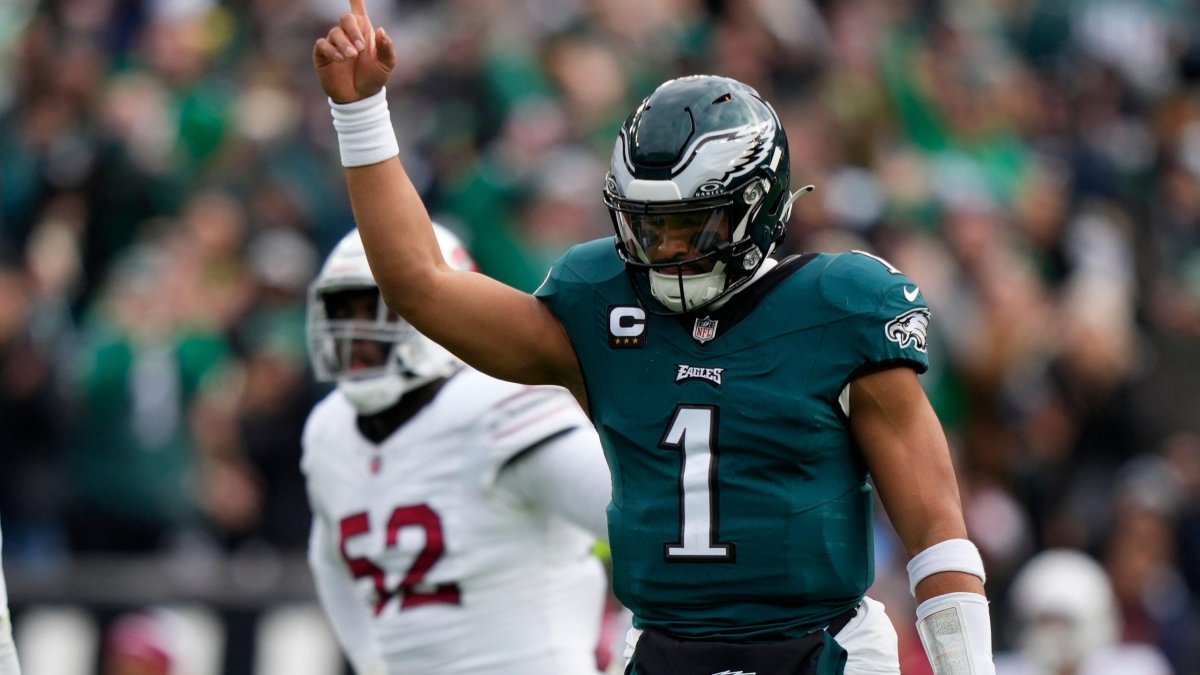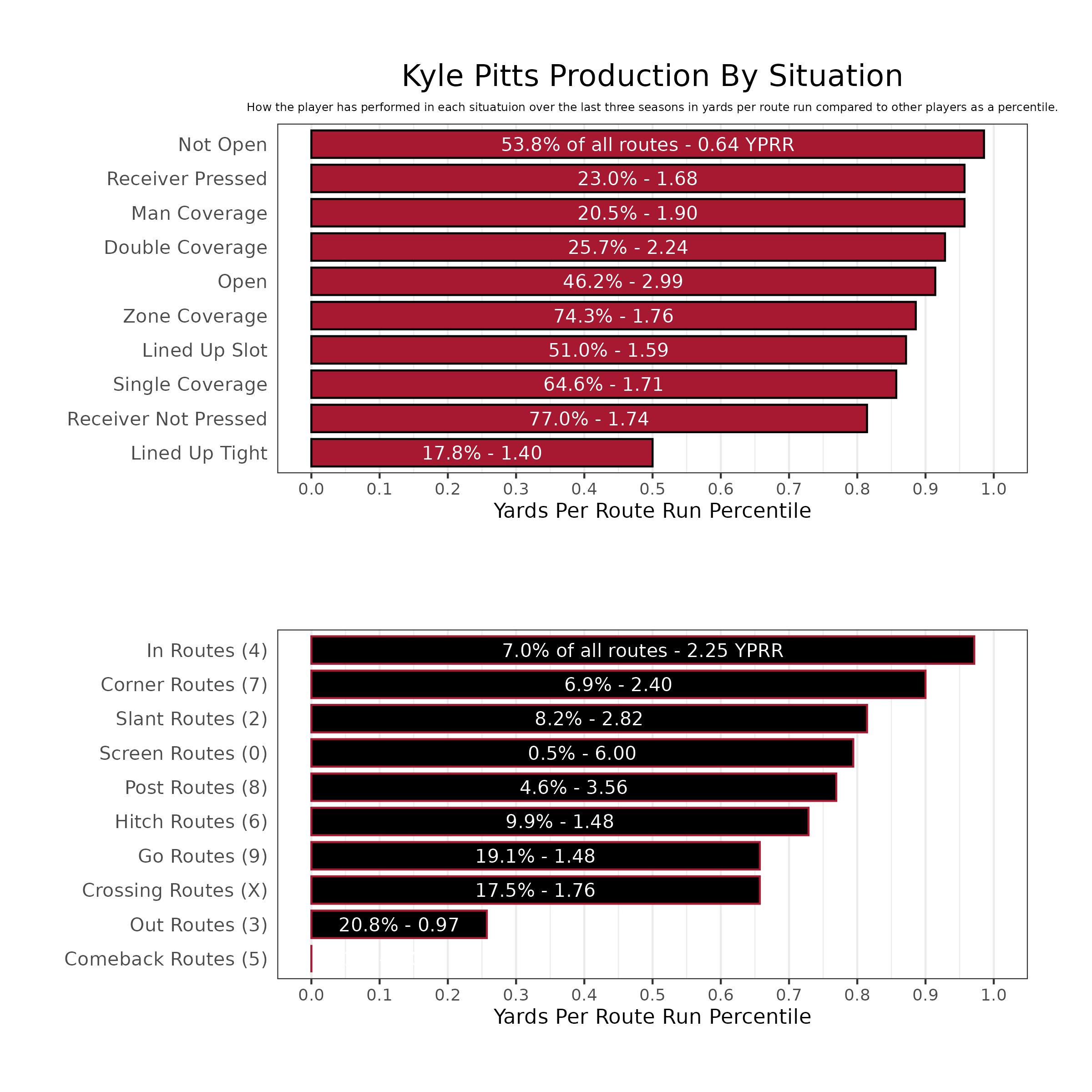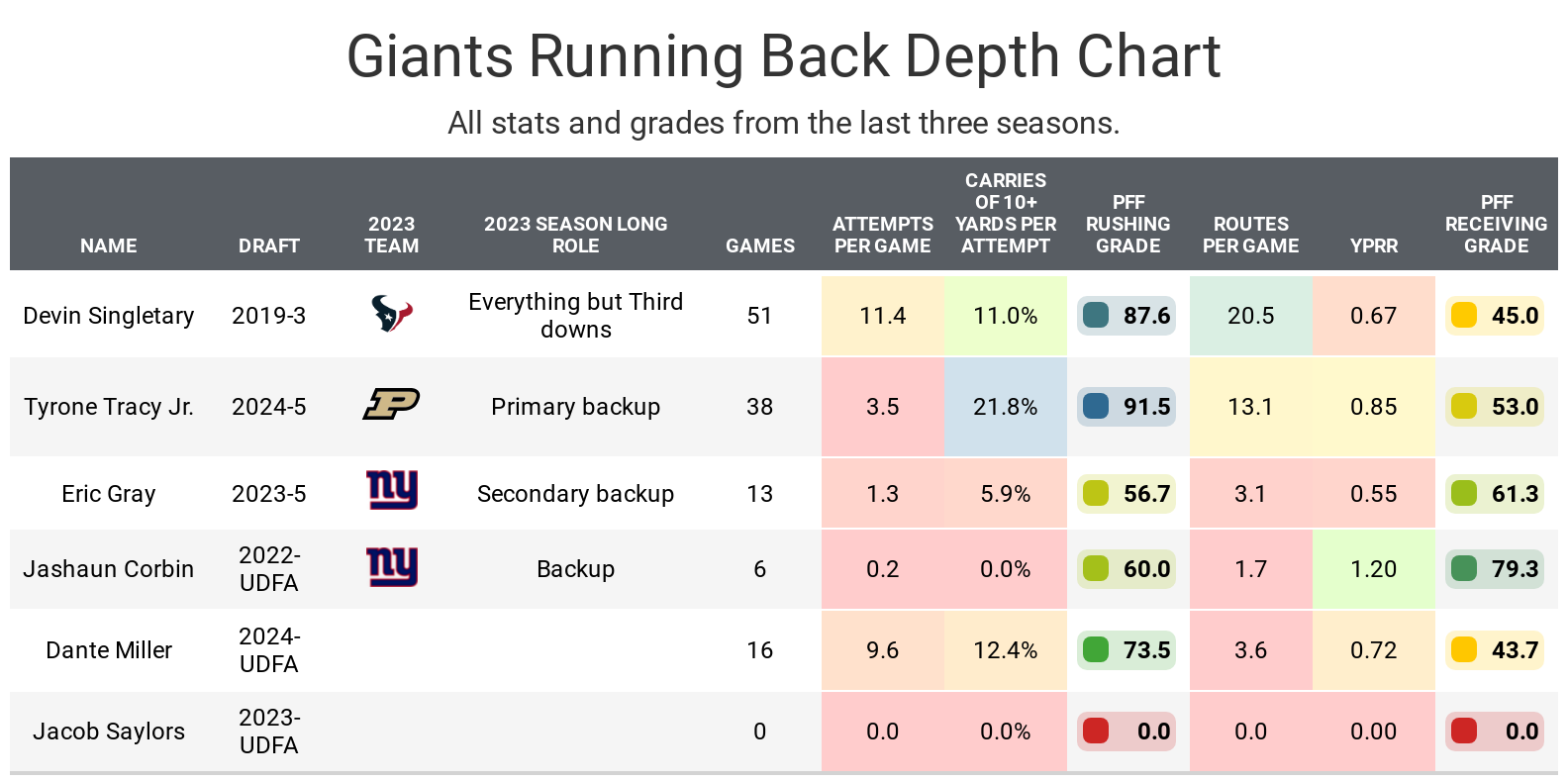


• A top-five wide receiver is guaranteed: The top six picks in most drafts should be Christian McCaffrey and the top-five wide receivers. Ja’Marr Chase is the ideal option from the fifth pick.
• It’s not too early to pick a quarterback in Round 3: Round 2 quarterbacks were league winners last year, and Josh Allen and Jalen Hurts fit that description again this year and can be drafted a round later.
• Dominate your fantasy draft: Subscribe to PFF+ to get full access to PFF’s full suite of fantasy football tools, including the fantasy mock draft simulator, live draft assistant, fantasy rankings, cheat sheets and more! Click here to subscribe!
The perfect draft series combines current ADPs from expert and casual drafts to see who should be available at each pick and make the best picks given that information. This draft is designed for 12-team PPR leagues for anyone picking fifth.
The only options here are a running back and wide receiver. In the first half of the first round, I lean wide receiver. The wide receivers are generally low-risk. At running back, the options are Breece Hall and Bijan Robinson, where there is much more risk. Aaron Rodgers might not target Hall much in the passing game while the Atlanta Falcons use a lot of Tyler Allgeier. The risks are very different.
Chase was WR5 as a rookie but has fallen just outside the top-10 the last two seasons because he missed time due to injury in 2022 while Joe Burrow missed time in 2023. He’s ranked among the top six in fantasy points per game each season when only including games where Burrow is healthy. Chase should benefit this season from Tyler Boyd leaving the team, allowing Chase to line up in the slot more often. All of the other wide receivers with a top-five ADP have lined up in the slot significantly more than Chase these last three seasons, and it’s time for Chase to catch up.
The options at this point of the draft are a high upside young wide receiver like Chris Olave or Drake London, or a running back like Travis Etienne Jr. or Isiah Pacheco. Both running backs have their limitations while both wide receivers are players on the rise who could end up at the top-10 at their position by the end of the year. Anyone picking in the first half of the draft can also generally find pretty good value at running back in Round 4, making wide receiver the pick here.
Olave has been an underrated wide receiver in his two years with the New Orleans Saints. His per-route production has been excellent. His 87.2 PFF receiving grade over his first two seasons ranks eighth among wide receivers over the past decade. Olave recently celebrated his 24th birthday, so we can still expect improvement from the budding superstar. He finished as the WR16 last season, and it’s fair to expect him to run more routes this year, leading to more production.

A quarterback is the ideal pick at the start of Round 3. These perfect draft articles constantly mentioned Josh Allen and Jalen Hurts at the end of Round 2 last season, and they ended up finishing first and second in fantasy points at the position. Both quarterbacks have changed this offseason, but their talent and rushing production still leave them squarely at the top.
In contrast, Jaylen Waddle, Chris Olave and DeVonta Smith were the other options to end Round 2 last season. All three were worthy of being fantasy starters, but none finished in the top 15 as their draft status implied. This year the other options are a top tight end, or other running backs and wide receivers who are likely fantasy starters but more of a gamble.
Hurts has averaged at least 21.0 fantasy points per start in every season of his career. While his tush push touchdowns have certainly helped his fantasy value, he’s one of just four quarterbacks with at least 2,200 rushing yards over the last three seasons while no one else is above 1,300. Considering one of those four is a backup and the other two are at an age where we stop seeing as much rushing production from quarterbacks, Hurts could be the best rushing quarterback this season. He is also surrounded by a top-three receiving corps and offensive line so even if his rushing touchdown total recedes, his fantasy production should remain high.
This is the last opportunity to draft a clear-cut starting running back. This running back tier is valuable if everything goes according to plan but a lot can go wrong. All six backs available at this point have averaged at least 14.5 PPR points per game over a significant stretch during the last two seasons, but most of the teams these running backs played for have invested a significant draft pick on another running back. Enough has been invested in these six that they are unlikely to completely disappear even if they lose playing time.
Mixon has been a consistent top-12 fantasy running back in both total ranking and points per game. Although he enters a new environment in 2024, he will again play in a high-scoring offense as the Houston Texans‘ clear lead running back. While he’s never been the most explosive running back, it’s fair to think he will finish in the top 12 yet again. Offensive coordinator Bobby Slowik recently said Mixon is “an absolute workhorse, in every regard.” The offenses Slowik has been part of generally run the ball more than average, which should continue to be true with Mixon.
The start of Round 5 is a sweet spot for adding a star tight end, which is why that position was ignored at the end of Round 2. The top tight ends available at this spot have either finished as top-six fantasy tight ends each of the last two seasons with the same quarterback and offensive play-caller or are a young tight end with a great opportunity to have a career year.
Pitts is a very talented tight end who has consistently underperformed in fantasy football. His 82.4 PFF receiving grade over the last three seasons is the fifth-best among tight ends, behind Travis Kelce, George Kittle, Mark Andrews and Dallas Goedert. Pitts’ utilization has been a major problem. Last season, he played over 75% of his team’s offensive snaps in only two games, with a 64% median. Zac Robinson will now orchestrate the Atlanta Falcons offense, which is a big reason for optimism regarding Pitts’ role this season. He’s expected to stay on the field and see a higher target rate.
Everything points to Pitts putting up better numbers this season if he can stay healthy. There is some uncertainty with the new offensive play-caller, new quarterback, and the limited sample size of tight ends as young as Pitts entering their fourth season. Pitts should be a clear fantasy starter this season, but he will need to find the red zone more often to break into the top five or higher. If everything goes right, he has the potential to be the overall TE1.

The options at this point are between wide receiver and running back. A lot of the running backs available in the next two rounds are currently overpriced, as they largely appear to be starting running backs, but a lot is working against them, which limits their upside. Picking back-to-back wide receivers leads to an imbalance at wide receiver compared to running backs, but that will just lead us to draft a lot of running backs later.
Rice finished as WR27 and was a top-36 wide receiver in nearly 70% of his games despite playing less than 70% of his team’s offensive snaps in all but four games. By Week 14, he began receiving playing time comparable to a typical starting wide receiver, playing at least 75% of his team’s offensive snaps from Weeks 14-17. During this period, he ranked eighth in fantasy points among wide receivers. In the playoffs, Rice played at least 75% of the Kansas City Chiefs‘ offensive snaps in three of four games, averaging 6.5 receptions for 65.5 yards per game against some of the NFL’s best defenses.
If not for the potential suspension, he would be considered a top-10 wide receiver this season. Even if he is suspended for the first six games, his fantasy value would increase simply by knowing he would be available for the fantasy playoffs.
While this team needs a second running back, it’s hard to pass up the value at wide receiver here. As mentioned above, there is a lot of value at wide receiver at this point of the draft, and it just happens to be based on ADP, there is a lot of value where this draft pick happens to be picking. Because of the constant wide receivers, the rest of this draft will go heavy at wide receiver.
Johnson finished as WR28 in 2022 while tied for sixth in targets despite rookie Kenny Pickett being his quarterback. He was traded to the Carolina Panthers. He should be the X receiver and the clear leader in targets. Everything indicates we could be in store for a similar season to 2022 this year if Bryce Young can’t improve. If Young does get better, we could see a season like 2021, when Johnson was the overall WR8.

After drafting only one running back to this point, it makes the decision for the next two rounds easy, picking the best available running back.
Williams was everyone’s favorite running back heading into the 2022 season. It wasn’t until Week 4 that he was finally unleashed and playing the every-down role people were hopeful for, but that role lasted for just a half, as he tore his ACL and LCL. Williams returned for the 2023 season, but as Broncos head coach Sean Payton recently acknowledged, it often takes two seasons before a player is back to full speed and strength after such an injury.
The Broncos brought back Jaleel McLaughlin and Samaje Perine in addition to drafting Audric Estime, giving Williams plenty of competition. There is a wide range of outcomes for Williams, ranging from him regaining a featured role to him getting buried on the depth chart, and everywhere in between. He has started both preseason games, while Estime hasn’t played with the starters and Perine might get released, making it likely Williams has a large role in the offense.
As mentioned above, this team needs a lot of running backs, and there is good value at running back at this point of the draft, with players who should at least see a lot of playing time, but also have the upside to be elite if they get a clear hold of the starting job.
Singletary has consistently graded well as a runner. He has recorded a 73.0-plus PFF rushing grade every season and at least a 78.0 mark in each of the past three seasons. He joins the New York Giants this season and should be the featured running back. He played in 29-of-33 snaps with the starters in the second preseason game, making it clear he will see more playing time than the vast majority of running backs picked ahead of him. Typically, feature backs are picked much higher, but he will be playing behind one of the worst offensive lines and has never graded well as a receiver. It’s also possible that he won’t play on third downs. That should prevent him from getting picked in the first half of drafts, but he can be a steal in the second half.

The next four rounds are mostly about picking your guys. If your favorite sleeper quarterback or tight end is available, it’s OK to pick them, but I’d lean toward stocking up on even more running backs and wide receivers. I lean toward picking a running back and wide receiver at each of the next two pairs of picks, picking whichever players are at the top of the board.
Lockett had been a consistent fantasy asset with four straight 1,000-yard and eight-plus touchdown seasons, but he gained fewer yards and caught fewer touchdowns last season at 31 years old. His decline was only in his statistics, as his PFF receiving grade was very consistent. He’s finished between 77.0-83.0 in each of the last six seasons. The Seahawks have a new offensive coordinator in Ryan Grubb. While everyone is excited for Jaxon Smith-Njigba, ideally, Grubb will be able to take advantage of Lockett’s talent to keep him fantasy-relevant.
Charbonnet was the third running back on our big board in 2023, just behind Bijan Robinson and Jahmyr Gibbs, and just ahead of De’Von Achane and Tyjae Spears. The second-round rookie won the third-down and two-minute drill job by November. He had three games playing over 60% of his team’s offensive snaps when Ken Walker III was injured, but those were against the Los Angeles Rams, San Francisco 49ers and Dallas Cowboys — three top-12 run defenses by PFF grade. The most likely scenario is he’s a passing back and handcuff to Walker, but with a new offensive coordinator in Ryan Grubb, we could see a completely different running back rotation — potentially one where Charbonnet is the starter.
Shaheed is a top-25 wide receiver over the last two seasons in yards per route run at 1.95. He was consistently the Saints’ third wide receiver in a part-time role with an offensive coordinator who loved rotating players out and in. The Saints didn’t re-sign Michael Thomas, which has likely elevated Shaheed to the second wide receiver in a full-time role. He could be a clear fantasy starter if healthy, but staying healthy has been a problem. He’s missed the recent preseason games with a toe and foot injury.

McLaughlin was the sixth-highest-graded running back last season with an 86.2 offensive grade. His yards per carry and avoided tackle rate were both top 10 among running backs. He also led all running backs in targets per route, leading to a top-10 yards per route run figure (1.63). McLaughlin didn’t receive any work with the starters in the Broncos’ first preseason game, but he played 11-of-20 snaps with the starters in the second game, including taking a third and long over Samaje Perine and taking snaps by the goal line. McLaughlin’s work ethic appears to be manifesting into a larger role with Denver.
Use any additional picks to pick a kicker and team defense if your league plays with them and forces you to draft them. If not, stock up on more running backs and wide receivers.